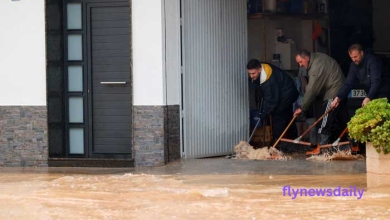
In an unprecedented catastrophe, devastating floods in Spain have claimed the lives of over 200 individuals, leaving countless others injured and displaced. This tragedy, which has unfolded across multiple regions, underscores the severe impacts of extreme weather events and the urgent need for preventive measures in vulnerable areas. As Spain grapples with this loss, we examine what happened, the causes of the floods, and the efforts being taken to aid affected communities. This comprehensive analysis of the Spanish floods sheds light on the disaster’s timeline, the regions most affected, and the immediate and long-term consequences for both people and infrastructure.
What Caused the Devastating Floods in Spain?
Heavy rainfall, unexpected storms, and overflowing rivers—all of which were made worse by climate change—were the main causes of the recent floods. A strong storm system’s intense rainfall overloaded local rivers and drainage systems, causing them to swell quickly and flood neighbouring towns and cities. This was combined with the effects of a cyclone that resembled a Mediterranean tropical storm, referred to locally as a “medicane,” which greatly increased the amount of rainfall, resulting in a disastrous situation.
Climate experts specifically identify rising Mediterranean Sea temperatures as a major cause of these extreme weather occurrences. Stronger storms and heavier downpours are caused by warmer oceans adding more moisture to the atmosphere. Weather patterns in Spain have been becoming more frequent and severe, which is indicative of a larger trend that climate experts believe is caused by global warming.
Regions Most Affected by the Floods
These floods have had a worldwide effect, with some regions seeing especially high levels of devastation. Complete communities have been inundated, and there has been significant property damage reported in southern and central Spain, which includes the Andalusian, Murcian, and Castilla-La Mancha areas. Large rivers like the Segura and Guadalquivir rose to dangerous levels, overflowing their banks and carrying away houses, cars, and farmland.
The city of Seville in Andalusia saw constant flooding, forcing many of its citizens to leave and seek safety in makeshift shelters. In a similar vein, hospitals, schools, and other vital infrastructure in Murcia suffered severe damage. Due to the soil saturation, Castilla-La Mancha also saw a number of landslides that cut off rural settlements and blocked roadways.
Infrastructure and Economic Losses
According to preliminary estimates, the floods would cause billions of euros in damages, which would have a huge economic impact. A major industry in these impacted areas, agriculture has been severely impacted, with large tracts of crops destroyed, livestock lost, and farmland rendered unusable. Roads, trains, and airports are just a few examples of the transportation infrastructure that has been severely damaged, making rescue and relief efforts more difficult.
The situation is made more difficult by the fact that thousands of people are now without basic utilities due to power outages and water supply interruptions. In some of the worst affected locations, it is anticipated that it would take weeks or even months to restore essential services, which will further affect local companies and hinder the pace of economic recovery.
The Human Toll: Lives Lost and the Displaced
With over 200 lives claimed and many more injured, the floods in Spain have been a human tragedy of monumental proportions. Search and rescue teams, including firefighters, the Spanish Red Cross, and the military, have been working around the clock to locate missing individuals. Unfortunately, in many cases, access to certain areas remains limited due to flooded roads and landslides.
Thousands of people have been displaced, forced to leave behind their homes and belongings. Emergency shelters have been set up across the affected areas to provide temporary housing, food, and medical assistance to those who have lost everything. The psychological impact on survivors, many of whom have lost family members or friends, is profound and will likely require long-term support.
Government and International Response to the Floods
Following the catastrophe, the Spanish government proclaimed a state of emergency in the impacted areas, coordinating relief efforts with local authorities and mobilising resources. In order to help in the recovery process, the government has also set aside emergency funds, which will cover rebuilding costs and compensation for the surviving family members.
Additionally, international aid has been provided by nearby nations and institutions like the European Union. Given the seriousness and urgency of the crisis, a number of EU member states have sent specialised rescue teams and offered financial support to help with relief efforts. The collaboration among nations emphasises the value of unity in the face of natural calamities, especially as climate-related catastrophes continue to escalate on a global scale.
Climate Change: A Growing Threat to Southern Europe
This catastrophic flood event in Spain underscores the increasing vulnerability of Southern Europe to climate change. Rising sea temperatures, unpredictable weather patterns, and more intense storms have become increasingly common in the region, with scientists warning that such events will only worsen if global carbon emissions remain unchecked.
Spain’s geography, with its coastal and mountainous regions, makes it especially susceptible to both droughts and floods, two opposing extremes that have become more frequent in recent years. The challenge for Spain and other Mediterranean countries lies in adapting to these changes by enhancing infrastructure, improving flood defenses, and investing in sustainable water management practices. However, this requires significant funding and political commitment, which remain ongoing challenges.
Lessons Learned and the Path Forward
The recent floods in Spain serve as a stark reminder of the importance of preparedness and proactive planning in disaster-prone regions. This includes investing in improved flood management systems, early warning systems, and resilient infrastructure capable of withstanding extreme weather conditions. Local governments are now faced with the task of rebuilding communities in a way that not only addresses immediate needs but also minimizes future risks.
Additionally, Spain must consider policies that promote climate resilience on a national scale. This could include stricter building codes for flood-prone areas, promoting sustainable agriculture practices, and prioritizing environmental conservation initiatives that protect vulnerable ecosystems. Such measures are essential to mitigate the impacts of future natural disasters and to safeguard the lives and livelihoods of those in at-risk regions.
How You Can Help Flood-Affected Communities in Spain
In the aftermath of such a devastating event, helping affected communities can make a significant difference. Charitable donations to trusted organizations involved in relief efforts can provide much-needed resources for those displaced. Donations of essential items, such as food, clothing, and hygiene products, can also aid in recovery. Additionally, raising awareness about the impacts of climate change and supporting policies that encourage environmental protection can help prevent future disasters of this scale.
Conclusion: The Urgent Need for Climate Action and Preparedness
The devastating floods in Spain are a somber reminder of the growing threat posed by climate change. As extreme weather events become more common, communities worldwide must adapt and prepare for the unexpected. Spain’s tragedy underscores the importance of urgent action on a global scale to combat climate change, as well as local measures that enhance disaster preparedness. By investing in sustainable practices and resilient infrastructure, Spain and other vulnerable regions can better protect their people and their future.



